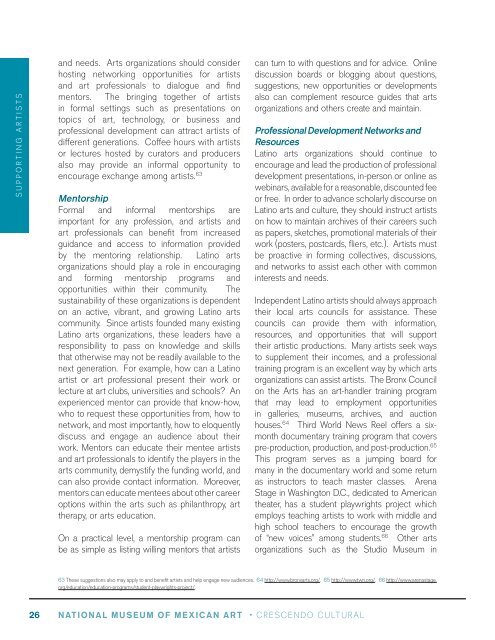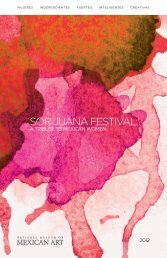Crescendo Cultural
Crescendo Cultural - National Museum of Mexican Art
Crescendo Cultural - National Museum of Mexican Art
- No tags were found...
You also want an ePaper? Increase the reach of your titles
YUMPU automatically turns print PDFs into web optimized ePapers that Google loves.
s tAb UPPortinG L e oF Contents Artistsand needs. Arts organizations should considerhosting networking opportunities for artistsand art professionals to dialogue and findmentors. the bringing together of artistsin formal settings such as presentations ontopics of art, technology, or business andprofessional development can attract artists ofdifferent generations. Coffee hours with artistsor lectures hosted by curators and producersalso may provide an informal opportunity toencourage exchange among artists. 63MentorshipFormal and informal mentorships areimportant for any profession, and artists andart professionals can benefit from increasedguidance and access to information providedby the mentoring relationship. Latino artsorganizations should play a role in encouragingand forming mentorship programs andopportunities within their community. thesustainability of these organizations is dependenton an active, vibrant, and growing Latino artscommunity. since artists founded many existingLatino arts organizations, these leaders have aresponsibility to pass on knowledge and skillsthat otherwise may not be readily available to thenext generation. For example, how can a Latinoartist or art professional present their work orlecture at art clubs, universities and schools? Anexperienced mentor can provide that know-how,who to request these opportunities from, how tonetwork, and most importantly, how to eloquentlydiscuss and engage an audience about theirwork. Mentors can educate their mentee artistsand art professionals to identify the players in thearts community, demystify the funding world, andcan also provide contact information. Moreover,mentors can educate mentees about other careeroptions within the arts such as philanthropy, arttherapy, or arts education.on a practical level, a mentorship program canbe as simple as listing willing mentors that artistscan turn to with questions and for advice. onlinediscussion boards or blogging about questions,suggestions, new opportunities or developmentsalso can complement resource guides that artsorganizations and others create and maintain.Professional Development Networks andResourcesLatino arts organizations should continue toencourage and lead the production of professionaldevelopment presentations, in-person or online aswebinars, available for a reasonable, discounted feeor free. in order to advance scholarly discourse onLatino arts and culture, they should instruct artistson how to maintain archives of their careers suchas papers, sketches, promotional materials of theirwork (posters, postcards, fliers, etc.). Artists mustbe proactive in forming collectives, discussions,and networks to assist each other with commoninterests and needs.independent Latino artists should always approachtheir local arts councils for assistance. thesecouncils can provide them with information,resources, and opportunities that will supporttheir artistic productions. Many artists seek waysto supplement their incomes, and a professionaltraining program is an excellent way by which artsorganizations can assist artists. the bronx Councilon the Arts has an art-handler training programthat may lead to employment opportunitiesin galleries, museums, archives, and auctionhouses. 64 third World news reel offers a sixmonthdocumentary training program that coverspre-production, production, and post-production. 65this program serves as a jumping board formany in the documentary world and some returnas instructors to teach master classes. Arenastage in Washington D.C., dedicated to Americantheater, has a student playwrights project whichemploys teaching artists to work with middle andhigh school teachers to encourage the growthof “new voices” among students. 66 other artsorganizations such as the studio Museum inHarlem and the national Museum of MexicanArt host formal artist-in-residence or internshipprograms, which have helped to catapult thecareers of many artists of color. 67Arts organizations have the greatest capacityto assist artists and bring their artwork tothe forefront because many understand theirprofessional needs and have networks by whichexchange and mentorship can thrive. they helplimit the barriers of entry for many artists whoseek greater opportunities to showcase theirwork. sometimes artists get lost in the educationdepartments of institutions and their art practiceand careers lie dormant. through its MasterArtist grant, the national Association of LatinoArts and Culture (nALAC) provides mentor andmentee stipends. 68 More established artists andidentified mentees apply jointly for the stipendsand both benefit professionally. the steel Yard inProvidence offers subsidized courses in jewelry,welding, blacksmithing, ceramics, and glasscasting. Artists have access to affordable studiospace, the metal shop, teaching opportunities,contract work through public art projects and aprivate project’s workbook at no cost.online resources and new media can also beuseful. Leveraging online resources and newmedia outlets can benefit these communities.Minneapolis’ Walker Arts Center leads the wayin providing a dedicated online networking spacefor local artists to connect both with the museumand with other artists through its Walker blogs. 69Hive Archive offers What it takes: Your indiebusiness buzz - informal monthly meetings forpeople who wish to develop their creative workinto a sustainable living. establishing an emaillist-serve to promote programs, activities, events,exhibits and performances is a useful way forarts organizations to encourage networking andpromote the arts.As a way to gain a greater understanding of thegrant application process, independent artistsshould participate on grant review panels. it isalso an excellent opportunity to network andlearn about the work of other artists and artsadministrators.Building Artist Spaces and CommunitiesMany artists want the opportunity to exchangeideas and bounce feedback with fellow artists andarts organizations. in essence, an open studiowill assist them in developing their art throughconstructive criticism in a friendly, safe spacethat many artists may not have had since school.Moreover, these artist gatherings permit the naturaldevelopment of mutually beneficial art projectsand engagements. Latino arts organizations canassist with the coordination of an open studio byproviding the space, inviting special guests whoare established and reputable artists to discusstheir work and critique others, and inviting theirsenior curatorial or programming staff to attend.several foundations like Ford and Kresge haveallocated resources to the creation of artistspaces for studio art and performance. some ofthese spaces are live-in and others are not. Whenpossible, Latino arts organizations should seize theopportunity to apply for these grants or assist artiststo submit a request and/or participate in thesefunding opportunities. established organizationscan provide financial stability, infrastructural, andresource development expertise for the creationand management of new artist spaces. 70Arts organizations should consider the possibilityof joining forces with other arts or communityorganizations that may also benefit fromnew spaces. through partnerships, multipleorganizations can fundraise, manage, and usethe new spaces for both artistic and othercommunity needs. new art and cultural spaces63 these suggestions also may apply to and benefit artists and help engage new audiences. 64 http://www.bronxarts.org/. 65 http://www.twn.org/. 66 http://www.arenastage.org/education/education-programs/student-playwrights-project/.67 sadly, el Museo del barrio’s previous artist-in-residence program has not been renewed. A former participant, Pepon osorio, later received a John D. and Catherine t. MacArthurFoundation fellowship. 68 http://nalac.org/index.php?option=com_content&task=view&id=382&itemid=412. 69 http://blogs.walkerart.org/. 70 this is a tall order for Latino artsorganizations, which are often challenged or encumbered by the management of their own programs and institutional needs. the creation of artist spaces often requires a capitalcampaign and then operating dollars and reserves to keep the spaces running long-term.26 NATIONAL MUSEUM OF MEXICAN ART • CresCenDo CULtUrAL NATIONAL MUSEUM OF MEXICAN ART • CresCenDo CULtUrAL 27



